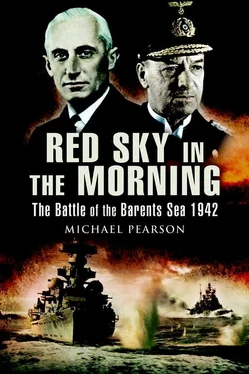For me as a young mate reporting onboard Z30 was a totally new experience. I was used to small boats, and this was a destroyer with a 300 man crew and a displacement of 3000 tons… At the beginning I found it very difficult to adjust to my new life because I was still a ‘greenhorn’. This was also the way my new comrades treated me. But with an ability to assert myself I managed to become accepted. I had the advantage that I suffered less with seasickness than most of the others… Thanks to the seasickness of my comrades I happily received double meal allocations… [40]
Radio communications aboard Z30 were carried out from two stations, the main radio room under the bridge and a second room aft which was manned during alerts. Johann Hengel’s task during alerts was to man the aft station with two radio operators. He was also trained to be radio mate for a prize crew should a freighter be captured. Z30 operated with the 5th Flotilla (North Sea), which later became the 8th Flotilla (Baltic Sea). Usually there would be six ships (half a flotilla) on station with the remainder at German yards for repairs and maintenance. The flotilla would often be based at Altenfjord, in company with Tirpitz and the mother ship controlling the Luftwaffe BV 138 reconnaissance aircraft scouring the Barents Sea for Allied shipping.
Despite the spectacular displays of the northern lights, long periods of almost perpetual darkness during the Arctic winter could be depressing for the German sailors (unlike their Allied opposite numbers, who welcomed the extra protection offered by the dark); however aboard Z30 , even during these periods, if there were no operations planned there was usually something to do, as the ship had thirty pairs of skis onboard. Despite the inhospitable climate and the inevitable stresses and dangers of war, not all Johann Hengel’s memories of Arctic service are bad:
The summer was a wonderful time, sunshine day and night… We tried to forget about the war, which we all hated… but nevertheless we did our duty. On occasion our destroyer berthed at the skerry of waterfalls, which enabled us ordinary seamen to take an extensive shower… We also sometimes went on shore leave into the mountains. Unexpectedly we found redcurrants, [and] in the early autumn we collected masses of mushrooms and blueberries on a lot of the islands. We would set out on small ships’ boats to catch plaice with sticks.
One only likes to think back to life’s good times. [41]
CHAPTER 3
THE BEST LAID PLANS…
Having accepted C-in-C Home Fleet Admiral Tovey’s recommendation to run the December 1942 convoy through to Murmansk in two fifteen-ship sections, designated JW51A and JW51B , the Admiralty put in hand plans to assemble the necessary merchant ships, cargoes, and escorts. This last proved to be an extremely knotty problem (see p. 17). Stretched between operations in the Mediterranean, home waters, and the Atlantic, and unable to obtain destroyers from the United States due to the requirements of Operation Torch , it was decided to reduce the close escort from fifteen to seven destroyers, with a detached covering force of two light cruisers in the Barents Sea, plus the Home Fleet heavy ships operating to the westward. Anxious to avoid repeating the fate of the cruiser HMS Edinburgh , torpedoed and sunk by U456 while part of the QP11 escort, Admiral Tovey proposed that the cruisers should proceed no farther than 25°E, roughly the meridian of the North Cape (see map A Map A – Movements 28–31 December (PRO. ADM. 234/369) Map B – Surface actions 08.30–12.00 hrs, 31 December (PRO. ADM. 234/369) Map C – Surface actions 12.00–13.00 hrs, 31 December (PRO. ADM. 234/369) Map D – Movements 31 December – 4 January (PRO. ADM. 234/369)
, p. 144), in order to avoid the U-boats which gathered around the convoys from that point onwards. In this he was overruled by the First Sea Lord, who maintained that they should shadow the convoy all the way through to Murmansk. As Admiral Tovey was later freely to admit, it was extremely fortunate that they did so.
—♦—
At Kriegsmarine Headquarters Northern Norway ( Gruppe Nord ), there had for some time been in existence a plan to attack Allied convoys using capital ships in a two-pronged pincer movement. Authorised by Grand Admiral Raeder to prepare for an operation against the next suitable target, Vice-Admiral Oskar Kummetz, Befehlshaber der Kreuzer (Admiral Commanding Cruisers – BdK), opted to amend this plan for his attack, designated Operation Regenbogen (Rainbow). Assembling a powerful battle group comprising the heavy cruiser Admiral Hipper (flagship), pocket battleship Lützow and six destroyers, he would commence an offensive sweep from astern of the convoy – by attacking from west to east he would have the benefit of what little light was available, silhouetting the convoy against the eastern horizon. Kummetz calculated that at that time of year he would have two to three hours of twilight, approximately 9 a.m. to 12 noon, during which to make his attack. After that, his heavy ships would be particularly vulnerable to night torpedo attack from enemy destroyers, and he had at all times to keep in mind Hitler’s strictures concerning minimum risk.
On locating the target he would take Admiral Hipper , (the faster of the two heavy ships) with three destroyers to make an initial attack from the northward. He could then reasonably expect the defending destroyers to concentrate against his squadron, while the now undefended convoy turned south, away from Hipper ’s attack – to be decimated by the waiting Lützow and her destroyers (see map, p. 32). As with any battle plan there were problems to be considered. The attack would be made in the depths of the Arctic winter, in what would almost certainly be adverse weather conditions with very little daylight; communications would inevitably be haphazard, and the attacking force would be split into two squadrons operating 75–85 miles (138–156 km) apart. Exceptional navigating skills and not a little luck would be required for the two attacking squadrons to arrive at their respective positions at the right time.
Operation Regenbogen – Admiral Kummetz’s plan of attack (Rodney L. Start, MBE, reproduced with the kind permission of Mrs Moira Start)
—♦—
The Royal Navy ‘O’ class destroyers Onslow , Obedient , (Lt-Cdr D.C. Kinloch, RN), Obdurate , (Lt-Cdr C.E.L. Sclater, DSC, RN), Oribi and Orwell (Lt-Cdr N.H.G. Austen, DSO, RN) operated in the Arctic from the start of the Russia convoys, and by December 1942 were old hands at the tricky and dangerous business of ‘riding shotgun’ for the lumbering merchant ships. However Captain Robert St Vincent Sherbrooke, DSO, RN, had been in command of Onslow and Captain (D) (senior officer) of the flotilla for a matter of weeks only. The close escort for the second section of the December convoy, JW51B , would be his first Arctic command. In addition to the five ‘O’s Sherbrooke would have at his disposal two destroyers from the Clyde Special Escort Force (a small reserve force of destroyers, based at Gourock, to strengthen convoy escorts when necessary), Achates (Lt-Cdr A.H.T. Johns, RN) and Bulldog plus the corvettes Hyderabad , RIN, (Lt S.C.B. Hickman, RNR) and Rhododendron (Lt-Cdr L.A. Sayers, RN), minesweeper Bramble (Cdr H.T. Rust, DSO, RN) and the trawlers Northern Gem (Lt H.C. Aisthorpe, RNR) and Vizalma which, in the absence of rescue ships, would assist with rescue work. The seven destroyers would come under the collective umbrella of the 17th Destroyer Flotilla.
Читать дальше












